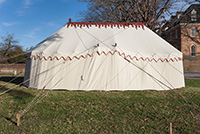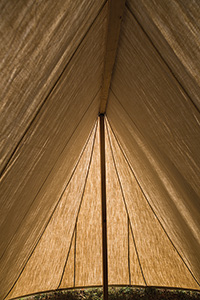« Back to main article “Hemp & Flax in Colonial America”
Sidebar:
Wanted Immediately for the Army…
by Mark D. Hutter, Colonial Williamsburg Supervisor of Historic Area Trade Sites

Tom Green
Colonial Williamsburg tailors worked with the staff at the Museum of American Revolution to reproduce George Washington's "First Oval Office."
So begin several advertisements placed on the Virginia Gazette in the autumn of 1775 by contractor — and later commissary general — William Aylett. Ranking high among his needs for the newly forming Virginia regiments was “a large quantity of DUCKING, or RUSSIA DRAB for tents.”
The need to shelter and clothe the soldiery was rapidly consuming available textiles. The army would be in the field come spring and it needed tents.
Ducking, or duck, drab and canvas were similar but separate fabrics by 18th-century linen manufacturers’ standards. They were imported to the colonies from a number of countries, including Russia, the Germanys, the Low Countries, Finland and Sweden. The thread count and finishing of the fabric made each of them distinct; the fiber and weave structure of the cloths make them akin to one another.
In the 18th century, these strong fabrics were woven of either hempen or linen threads and have more threads per the inch in their warp (threads in length of the fabric) than in the weft (threads that run selvage to selvage across the fabric). Both the fiber and the weave of these fabrics made them suitable for tents, the covers of wagons, sails of ships and the sturdiest of work-a-day clothing. The closely set threads of the warp created minute gutters that directed water along its length; tents and sails, for example, were always made with the length of their fabrics running vertically. The pitch of a tent’s roof held taunt by ropes helped to shed the wet weather. Linen and hemp fabrics swelled when wet, making them more impermeable. Soldiers could stay comfortably dry in canvas tents — until someone touched the wall, starting an endless drip.
Unfortunately, with five or six common soldiers sharing a wedge-shaped tent that was 6 feet x 7 feet, the chances of not touching the wet wall were slim. Officers were afforded more room. Company officers often slept two to the common tent or better yet, a larger, walled horseman’s tent when available. Field officers, colonels and those of higher rank were allowed oval-shaped tents called marquees.
Tailors, sail-makers and upholsters throughout the colonies took up needle and shears in the name of liberty and went to work sewing tents for America’s army. Of the thousands of tents produced during the Revolution, the only two that are known to have survived are those of General Washington — his private sleeping and office marquee, and the larger dining and meeting marquee. Their now fragile pieces are scattered between the collections of the Smithsonian Institution, the National Park Service at Yorktown, and the Museum of the American Revolution (MoAR) currently being built in Philadelphia.
Over the past several years the tailors of Colonial Williamsburg’s Department of Historic Trades have worked with MoAR’s staff to study and document the linen canvas roof and wall in their collection, which was once used as the commander in chief’s field headquarters and referred to, somewhat tongue-in-cheek, as the first Oval Office.
During the summer of 2013, the tailors and a crew of tent-makers replicated Washington’s office marquee, as other trades made the accompanying mahogany poles, iron fittings, oak tent pins and leather valises, all based on the originals already in museum collections. Two of Washington’s 18 camp stools survive — one at the Smithsonian and one at Tudor Place — while his camp bed is at Mount Vernon; these have been replicated by the joiners.
The cooperation of these museums, the scholarly scouring of period images and texts for related information, and the talent of Colonial Williamsburg’s skilled trades have resulted in a remarkably detailed reconstruction of Washington’s wartime home. Unlike his contemporary commanders, Washington spent much of the war in the field and in his tent when others more frequently commandeered homes. He wrote of himself that “I will not soon quit a tent once I am in one,” which endeared him to his men.
Visit the First Oval Office on Facebook or the Museum of the American Revolution website for more information about the history of Washington’s marquees, for updates on the ongoing project or to find information about when and where the reproduction field headquarters will be exhibited.

